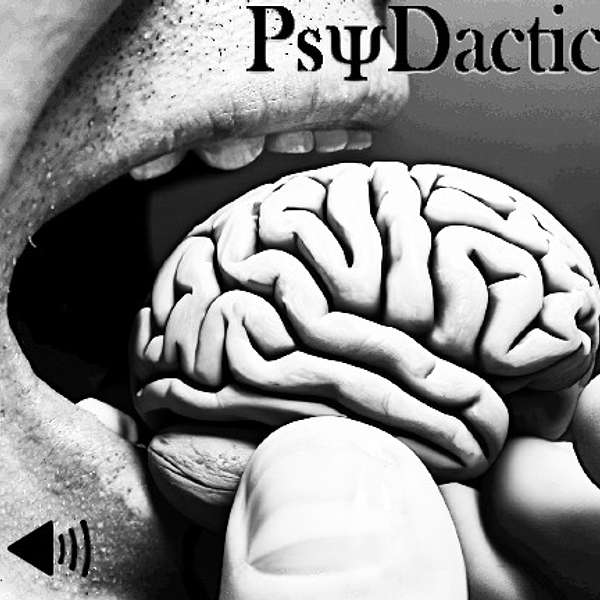
PsyDactic
A resource for psychiatrists and other medical or behavioral health professionals interested in exploring the neuroscientific basis of psychiatric disorders, psychopharmacology, neuromodulation, and other psychiatric interventions, as well as discussions of pseudoscience, Bayesian reasoning, ethics, the history of psychiatry, and human psychology in general.
This podcast is not medical advice. It strives to be science communication. Dr. O'Leary is a skeptical thinker who often questions what we think we know. He hopes to open more conversations about what we don't know we don't know.
Find transcripts with show-notes and references on each episodes dedicated page at psydactic.buzzsprout.com.
You can leave feedback at https://www.psydactic.com.
The visual companions, when available, can be found at https://youtube.com/@PsyDactic.
PsyDactic
Neuronal Networks: The Attention Networks
Today, I am going to explore the Attention Networks, which are the parts of our brain that get really excited when, for example, we see something that we have never seen before, something that appears to be moving on its own volition (and might harm us), something that appears out of place (like an eyeball on the floor), or something that reminds us of something we really want (I’ll let you pick the example).
Please leave feedback at https://www.psydactic.com or send any comments to feedback@psydactic.com.
References and readings (when available) are posted at the end of each episode transcript, located at psydactic.buzzsprout.com. All opinions expressed in this podcast are exclusively those of the person speaking and should not be confused with the opinions of anyone else. We reserve the right to be wrong. Nothing in this podcast should be treated as individual medical advice.
Welcome to PsyDactic - Residency edition. I am Dr. O’Leary, a 3rd year psychiatry resident in the National Capital Region. Every week I try to come up with a new and creative way to give the disclaimer that, even though I am a doctor, I’m only human. This podcast will never rise to the level of peer reviewed articles. I don’t have the time or funding source for that. I am a resident psychiatrist, so no institution in their right mind would let me speak for them without strict oversight. In fact, to drive home the fact that I represent no other institution and am not giving medical advice here, I wanted to start this episode with a limerick.
Ahem,
There once was a Doc from the Capital
Who could not quite shut off his trap at all
He turned on a mic
The feedback did spike
For his psych-theatrical rap battle.
Speaking of feedback. If you want to give me some, you can go to psydactic.com and fill out a form at the bottom of the page there. That’s psydactic.com. If you want references or to read the transcript, then go to psydactic.buzzsprout.com and poke around amongst the growing list of episodes for the transcript link.
If I were to say to you, “Pay attention!” and you did, then most of us would assume that you were also conscious of what you were paying attention to. Attention and consciousness seem almost synonymous or at least part of the same thing. But are we really conscious of where our attention is taking us? If you’ve ever observed someone with Attention Deficit Hyperactivity Disorder (even if that person is yourself), you may wonder if paying attention to something is the same thing as being conscious of it.
Today, I am going to explore the Attention Networks, which are the parts of our brain that get really excited when, for example, we see something that we have never seen before, something that appears to be moving on its own volition (and might harm us), something that appears out of place (like an eyeball on the floor), or something that reminds us of something we really want (I’ll let you pick the example).
There are two somewhat distinct Attention Networks in the brain, and because they were named by neuroscientists, who are great at spatial orientation, they are called the dorsal and the ventral networks.
The dorsal network is uniquely composed of brain matter in the intraparietal sulcus and the frontal eye fields. The intraparietal sulcus is the depression that separates the superior and inferior parietal lobes. This part of the parietal lobe helps us orient in space and do things like point in the right direction and grab something we are reaching for. The other main part of the dorsal attention network, the frontal eye fields lay just anterior to the primary motor cortex, which makes sense because they are primarily involved in helping our eyes move together. The intraparietal sulcus helps orient our movements in space and the frontal eye field help us to track things moving in space. It may seem obvious that would be integrated into an attention network.
The ventral attention network also has two primary regions contributing: the region containing the temporoparietal junction and supramarginal gyrus and the ventral frontal cortex. That's a lot of words to get lost in.
The location of the temporoparietal junction is in the name and its neighbor the supramarginal gyrus is the gyrus right where the line created by the flappy of the temporal lobe meets the parietal lobe. But what is the ventral frontal cortex? It is NOT the ventromedial prefrontal cortex. That was part of the default mode network. The ventral frontal cortex that is part of the ventral attention network is distinct. It is just beside and above where the anterior or front part of the flap of temporal lobe hugs the frontal lobe.
Maybe it would make more sense if I explained it like this. Imagine a mushy brain is sitting on the table in front of you. It is oriented in the same direction as the brain in your own head. If you grab it by the lower sides, you’ve grabbed the temporal lobes. If you run your thumb along the margin between the temporal lobe and the rest of the brain until you get to the front and then touch the part of the frontal lobe just next to it, you're touching the ventral frontal lobe, specifically the frontal operculum. They call it the operculum because if you lift it up you’ll see the anterior insula. So it's like a window to the insula. Now, slide your thumbs back along that same margin until it is in the butt-crack of the brain right where the margin ends and the parietal lobe begins. That is the supramarginal gyrus you are violating right now. Go a little farther back past that and you're at the junction of the parietal lobe and the temporal lobe.
I wonder how much of my parietal lobe was involved in coming up with that imagery just now?
Now drop that floppy brain down on the table, appreciate its satisfying jiggle and let's get back to work.
The parts of the ventral attention network near where the parietal and temporal lobes come together are responsible for being able to recognize details in spatially oriented stimuli. In classic experiments, lesions to this area might make someone unable to see that a bunch of letter E’s arranged in the shape of an S were not merely just a big S. Metaphorically you could say that this part of the brain is necessary for picking the trees out of the forest.
The ventral frontal parts, that operculum and maybe even parts of the anterior insula are involved in… well, I’m not quite sure. All descriptions I found were either vague or the language was so technical that I couldn’t really follow it. There is a lot going on in that part of the brain and it seems like this part of the brain might be important for integrating information from multiple senses and deciding what to give the most attention to. I have read the term “flexible decision making” in multiple places. Comparisons with macaque brains showed that we have a lot more going on there that they do, so this part of the brain might be particularly important to making us human.
It is commonly reported that the Ventral Attention Network is right side dominant, but some researchers have questioned just how dominant this dominance actually is, but that is beyond the scope of this episode.
To summarize again, there are two primary attention networks. There is the Dorsal Attention Network, composed of the intraparietal sulcus and the frontal eye fields, which helps us focus on and track things through space. You could call it our spacetime system because it helps us maintain task driven focus over time on objects moving through space. The other is the Ventral Attention Network composed of areas around the temporoparietal junction and the ventral frontal cortex, and helps us pick details out of the environment to pay attention to and make decisions as to what details need our focus.
Some have characterized the Dorsal Attention network as top-down, meaning that it tells the rest of the brain what to pay attention to like an executive giving commands to the managers. The Ventral Attention Network has been described as more bottom-up, taking details and sensory information from the environment and bringing it to the attention of the executors. I’m sure any simplified characterization like this is probably missing something.
But what are we supposed to do with all of this attention that we can give to things? How do we really decide what is worth giving attention to? How do we stay on task without getting distracted? How would we know when we need to get distracted? How do we not get distracted by things like our own thoughts?
In the next episode, I am going to discuss something called the Salience Network which gives value to different things competing for attention. The Dorsal Attention network can maintain attention through space-time, the Ventral Attention network can pull out details from the noise, and the Salience Network will help us decide what details are important and need action.
But that is for next time. I am Dr. O and this has been an episode of PsyDactic Residency Edition.
Bibliography
1. Vossel S, Geng JJ, Fink GR. Dorsal and ventral attention systems: distinct neural circuits but collaborative roles. Neuroscientist. 2014 Apr;20(2):150–9.
2. Onofrj V, Chiarelli AM, Wise R, Colosimo C, Caulo M. Interaction of the Salience Network, Ventral Attention Network, Dorsal Attention Network and Default Mode Network in Neonates and Early Development of the Bottom-up Attention System. Res Sq. 2021 Sep 8;
3. Robertson LC, Lamb MR, Knight RT. Effects of lesions of temporal-parietal junction on perceptual and attentional processing in humans. J Neurosci. 1988 Oct;8(10):3757–69.
4. Neubert F-X, Mars RB, Thomas AG, Sallet J, Rushworth MFS. Comparison of human ventral frontal cortex areas for cognitive control and language with areas in monkey frontal cortex. Neuron. 2014 Feb 5;81(3):700–13.
Podcasts we love
Check out these other fine podcasts recommended by us, not an algorithm.

Mindhunting: Journeys in Forensic Psychiatry
Dr Michael Schirripa
Brain Science with Ginger Campbell, MD: Neuroscience for Everyone
Ginger Campbell, MD
